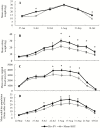Diversified Farming in a Monoculture Landscape: Effects on Honey Bee Health and Wild Bee Communities
- PMID: 32249293
- PMCID: PMC7371362
- DOI: 10.1093/ee/nvaa031
Diversified Farming in a Monoculture Landscape: Effects on Honey Bee Health and Wild Bee Communities
Abstract
In the last century, a global transformation of Earth's surface has occurred due to human activity with extensive agriculture replacing natural ecosystems. Concomitant declines in wild and managed bees are occurring, largely due to a lack of floral resources and inadequate nutrition, caused by conversion to monoculture-based farming. Diversified fruit and vegetable farms may provide an enhanced variety of resources through crops and weedy plants, which have potential to sustain human and bee nutrition. We hypothesized fruit and vegetable farms can enhance honey bee (Hymenoptera: Apidae, Apis mellifera Linnaeus) colony growth and nutritional state over a soybean monoculture, as well as support a more diverse wild bee community. We tracked honey bee colony growth, nutritional state, and wild bee abundance, richness, and diversity in both farm types. Honey bees kept at diversified farms had increased colony weight and preoverwintering nutritional state. Regardless of colony location, precipitous declines in colony weight occurred during autumn and thus colonies were not completely buffered from the stressors of living in a matrix dominated with monocultures. Contrary to our hypothesis, wild bee diversity was greater in soybean, specifically in August, a time when fields are in bloom. These differences were largely driven by four common bee species that performed well in soybean. Overall, these results suggest fruit and vegetable farms provide some benefits for honey bees; however, they do not benefit wild bee communities. Thus, incorporation of natural habitat, rather than diversified farming, in these landscapes, may be a better choice for wild bee conservation efforts.
Keywords: Apis mellifera; diversified farming; honey bee; wild bee.
© The Author(s) 2020. Published by Oxford University Press on behalf of Entomological Society of America. All rights reserved. For permissions, please e-mail: journals.permissions@oup.com.
Figures





References
-
- Adhikari S., Burkle L. A., O’Neill K. M., Weaver D. K., Delphia C. M., and Menalled F. D.. . 2019. Dryland organic farming partially offsets negative effects of highly simplified agricultural landscapes on forbs, bees, and bee-flower networks. Environ. Entomol. 48: 826–835. - PubMed
-
- Aizen M. A., and Harder L. D.. . 2009. The global stock of domesticated honey bees is growing slower than agricultural demand for pollination. Curr. Biol. 19: 915–918. - PubMed
-
- Alaux C., Allier F., Decourtye A., Odoux J. F., Tamic T., Chabirand M., Delestra E., Decugis F., Le Conte Y., and Henry M.. . 2017. A ‘landscape physiology’ approach for assessing bee health highlights the benefits of floral landscape enrichment and semi-natural habitats. Sci. Rep. 7: 40568. - PMC - PubMed
-
- Arduser, M. 2016. Key to the genera and species of the Midwestern United States with an emphasis on the Tallgrass Prairie region. (http://www.pwrc.usgs.gov/nativebees/Keys.html).
-
- Ascher J. S., and Pickering J.. . 2015. Discover life bee species guide and world checklist (Hymenoptera: Apoidea: Anthophila) (http://www.discoverlife.org./mp/20q?guide=Apoidea_species).
Publication types
MeSH terms
LinkOut - more resources
Full Text Sources

